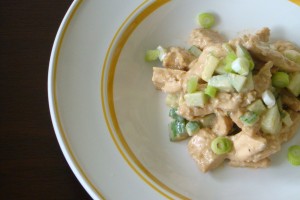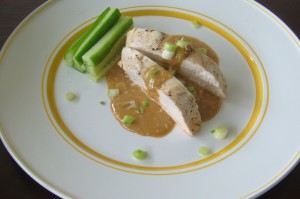 A certain member of my family, who shall remain nameless, is quite famous for having once attempted to cook a chicken in the microwave. I was not alive when these events took place (nor was the chicken), but even I will tell this story (it’s just that sentence) at family and other dinners, to either the chagrin or good-humored delight of the guilty party, if she is present, and depending on the wine involved. How silly, I would say, and we would all laugh. Who would try to cook raw chicken in the microwave?
A certain member of my family, who shall remain nameless, is quite famous for having once attempted to cook a chicken in the microwave. I was not alive when these events took place (nor was the chicken), but even I will tell this story (it’s just that sentence) at family and other dinners, to either the chagrin or good-humored delight of the guilty party, if she is present, and depending on the wine involved. How silly, I would say, and we would all laugh. Who would try to cook raw chicken in the microwave?
Well, Japan would. Home to one of the finest cuisines in the world, with its utmost respect for seasonality, endless attention to detail, and unerring focus on  variety of color, taste, texture, technique, and appearance in all its meals. Japan would cook raw chicken in the microwave.
variety of color, taste, texture, technique, and appearance in all its meals. Japan would cook raw chicken in the microwave.
Asian kitchens do not tend to have ovens. Their inhabitants do not tend to miss them, either. (Except me, of course, for the two years when I lived there.) Things are steamed, simmered, boiled, stir-fried, seared, and other things (like microwaved). They just aren’t cooked in ovens, and I’ve heard that Asians who have immigrated to the United States or Europe will often use their ovens for storage, preferring their stoves and microwaves instead. How silly, I might have said. What would you do with that raw chicken?
This.
Steamed chicken with sesame
Adapted from Harumi’s Japanese Cooking
Harumi Kurihara has been called the Martha Stewart or Delia Smith (depending on which country you’re in) of Japan. This little book of hers, published several years ago, was her first English language venture. Her sensibility is well-suited to the home cook who lacks lots of time, and includes many recipes that take an East-West approach with the rare and delightful result of unfussy, non-muddly, fusion-y food. This preparation, however, is somewhat more purely Japanese. If you are snobbish about your microwave, then you should probably get rid of it, but you may steam your chicken the old-fashioned way. For the record, this method is very fast and very good.
For the salad: 1 skinless, boneless chicken breast (about ½ pound/250 g) | kosher salt + pepper | 4 scallions | 1 T sake | 1 t sesame oil | small piece ginger, crushed | 2 small cucumbers, cutely cut up
For its dressing: ¼ cup sesame paste* | 2 T soy sauce | 1 T sugar | 1 t rice vinegar | chile flakes, powder, or paste, to taste | 1 t grated ginger | 1 small clove garlic, also grated | 2 T sesame seeds
Pierce the chicken several times with a skewer and season on all sides with salt and pepper. Place in a microwave proof bowl. Cut off the dark green part of the scallions and place on top of the chicken. Finely chop the rest, and set aside. Add the sake, sesame oil, and piece of ginger to the chicken bowl, cover, and microwave on high for 4 minutes. Leave to cool.
Meanwhile, mix all the ingredients for the dressing together. Taste and adjust seasoning to your liking. Then remove the chicken from its bowl, discard the ginger and scallion bits, and pour the juices into the dressing. Stir and taste again. Add water if it is too thick.
To serve as a salad: Shred the chicken with your hands, and toss it with the chopped scallions, cucumbers, and dressing. More fussily: Slice chicken on a bias, fanning the pieces out on a plate, stir some of the scallions into the dressing, reserving a few, then drizzle the sauce over the chicken, and garnish with the cucumbers and remaining scallions.
Serves 4 as an appetizer, 2 as a main course
* Japanese sesame paste would be preferable, but tahini is an appropriate substitute, and what I used.
{ 5 comments… read them below or add one }
I knew that there were no ovens. But I never thought microwaving possible.
I loved your remarks about the Japanese cooking in microwaves, none of which I knew. I will no longer hide the fact or apologize that I use my microwave alot….THANK YOU for this recipe! I am eager to try it and improve my microwaving skills!
That is very interesting about the Japanese. Actually I think the chicken salad recipe looks really good. I will try it!
The version that my mother makes (yes, chicken breast cooked with a microwave, and then hand shredded) adds cellophane noodles, or mung bean sheets, or Korean dangmyeon made from sweet potato starch. In Chinese this is called “Ji Si La Pi” (雞絲拉皮). Lovely blog, by the way!
Yay for microwaved chicken! And love the Chinese + Korean food lessons! I also hear you have a good kimchi recipe…